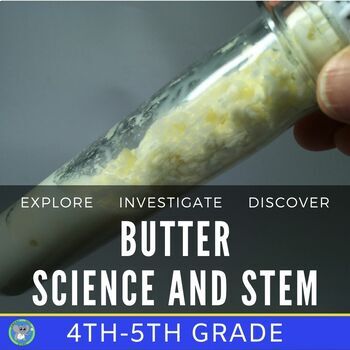Food Science And STEM | Making Butter Experiment | Gr 4 5 Thanksgiving Activity
- PDF
- Easel Activity
What educators are saying
Also included in
- Bundle and SAVE on this collection of our favorite science and STEM holiday activities. You will get 7 project-based units that are popular for Halloween, Thanksgiving, Christmas, Valentine's, Saint Patrick's Day, and Easter. They meet the standards and can be used anytime, too!Each Unit IncludesAnPrice $32.92Original Price $41.15Save $8.23
- Be amazed at how easy it is to make butter. This is a perfect science unit for the elementary science lab teacher on dairy products. Supplies are simple and inexpensive, and a teacher guide is provided. Bundle and save! Use for a Thanksgiving Unit and meet the standards at the same time StudentsPrice $12.20Original Price $15.25Save $3.05
Description
Do you know how butter is made? It is easy to make, and the science is fascinating. Expand students’ knowledge of butter churning. This complete 4th/5th-grade unit contains a teacher guide to improve success. Students investigate the role of fat and cream. A further exploration activity and a STEM Challenge to separate the butter from the buttermilk are included. Great activity for Thanksgiving.
Can I use this virtually? The files are PDF but come with a pre-created Easel by TpT overlay. We added text boxes and tips for completing it online. Click "Open in Easel" to get started. We recommend printing the journal and conducting it in class. Then send the reading passages and assessment digitally. Great for hybrid students. They can be added to your Google Classroom as an assignment. Students can also print and complete. If you don't have Google Classroom, you can send the overlay as a link to Google accounts. If that is not possible, use the PDF in a program like Kami extension to create an online version with text boxes. We already did it for you in Easel. You could conduct the experiment as a demo for the students, and then they try it. Get creative! Make sure you download the PDF for the answer keys, instructions, and tips.
Students will follow the scientific method in an engaging lab to learn which cream will make the thickest butter. Students will collect, graph, and analyze their data. Using their evidence, they will write a summary and conclusion. Students will read comprehension pages and answer questions to learn the science behind butter. It integrates well with lessons on settlers and Thanksgiving. They will explore further in an exploration to test a milk product of choice. A final STEM challenge will have them design a method or tool to separate butter from buttermilk.
By the End of the unit, students will be able to answer the question:
Does the amount of fat in cream affect the thickness of butter?
The journal meets the Next Generation Science Standards
- 5th Grade Matter and Its’ Interactions
- 3-5 Science and Engineering Practices
Teachers will like its’ ease of use, simple materials, and background information. They will enjoy the process the students go through in learning about butter and how it integrates with the properties of matter. Teachers can integrate it with social studies and Thanksgiving time. Teachers like watching students perform a hands-on activity and taking the lead on their learning. They appreciate the attention to detail in the background information and teacher tips. This unit is a nice expansion from the 2nd/3rd-grade version.
The investigation can be completed in 1-2 lab periods. If you complete the whole unit, it should take a week.
This hands-on Investigation and Teacher guide includes:
- Alignment with NGSS
- Background Information and Teacher Tips
- My Butter Churning Investigation
- Two Reading Comprehension Pages expanded from the 2nd/3rd Grade version
- Further Exploration Activity with CER Page
- STEM Challenge
- Student Assessment
- Rubric and Answer Keys
Supplies Needed
Heavy whipping cream, half and half cream, fat-free half and half cream, marbles, baby soda bottle test tubes or similar containers, plastic knife, popsicle stick, graduated cylinder, paper plates, time, other types of milk and cream, and standard supplies for a STEM Challenge It does not take much cream for each test.
Great for the classroom, science fair, STEM fair, Science Lab/STEM Class, homeschool, health lesson on milk, science club, and Thanksgiving Unit.
This investigation is part of a series. This is the 4th/5th-grade investigation. K/1st and 4th/5th grades are also available. Each version is differentiated for abilities and the Next Generation Science Standards. K/1st grade tests with and without fat and includes further exploration ideas. 2nd 3rd grade increases the amount of fat to include 3 tests. 4th/5th grade also increases the amount of fat, increases to 3 trials, and expands on the expectations. Both grades include a further exploration and STEM challenge. All are available for a bundle discount. The bundle also helps you to differentiate for students.
Butter Science: Experiment Butter Churning With K-1st Grade
Butter Science And STEM Challenge: Butter Experiment For 2nd/3rd Grade
Butter Science Experiment and STEM Challenge: K-5th Grade Bundle
You might also like
Gravity And Motion: Investigate And Explore Marble Roller Coasters
Heart Rate And Exercise Experiment: A Lab For 4th/5th Grade
Elephant Toothpaste Lab: Experiment with Exothermic Chemical Reactions
Remember leaving feedback earns you points toward FREE TPT purchases. We love hearing how the investigation went.
Also, follow us and be notified when new explorations are uploaded and deals.
Please contact us with any questions! We are here to help.
Yours in Science,
Kimberly Scott
All parts are copyrighted. Please see the Terms of Use in the download.








